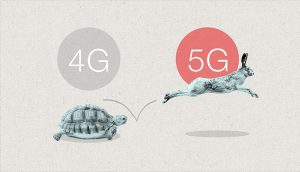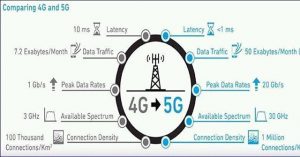MARCH 1, 2020

FOSTER CITY, CALIFORNIA – If you’ve turned on the TV or browsed the web since the start of the year, you’ve undoubtedly been barraged with news and ads about 5G, the next generation wireless technology.
What you probably haven’t heard or seen much of, however, is real explanations of what benefits 5G will bring to everyday people versus the 4G service we almost all have today.
Sure, you may have heard or seen a few comments on speed improvements that come with 5G, but they’re exceedingly short on details and, frankly, don’t really give a complete (or accurate) picture of what you can expect right now in normal use. So, without further ado, here’s what 5G can do for you right now.
Not much.
Ok, that’s a bit harsh, but for most people in most locations, the reality is that even if they go to the effort of buying one of the few 5G-capable phones now available for purchase (and remember, you have to do that before you can even start talking about the potential benefits of 5G), their day-to-day experience isn’t going to be much different.
Except for a few locations in a few cities around the country, the download speeds on most 5G phones will not be noticeably different from what you experience with your 4G LTE phone today. So, if you think your shiny new 5G phone will give you a leg up on friends and family when it comes time to download Season 4 of “Stranger Things” on Netflix, well, it ain’t necessarily so.

Why should I buy a 5G phone?
The real reason to buy a 5G phone today (or in the near future) is to prepare you for what is still to come.
The 5G networks will offer some solid improvements over today’s 4G LTE networks, but most of those benefits are a ways off. However, industry trends show that most people are now holding onto their phones much longer than they used to – in some instances because of how expensive the latest smartphones have become. So, when it does come time to replace your current phone, getting a 5G-capable model is a good future-proofing decision.
Why?
First, the speed benefits of using a 5G phone on a 5G network will start to become more apparent later this year and into next. It’s important to understand, however, that those benefits aren’t necessarily going to be equal on all devices or on all carriers or in all locations, due to a number of different factors.
All 5G is not the same
Most significantly, there are multiple “flavors” of 5G that use different types of radio signals to send and receive data and each of these different flavors has very different characteristics.
The two main types of 5G service are typically referred to as millimeter wave – often shortened to mmWave – and sub-6 GHz. Just to make things more confusing, the sub-6 segment can be broken down into two sub-segments, typically called low-band and mid-band.
The technical details behind all this can get very confusing, but the bottom line is that mmWave technology (which is the only version of 5G that Verizon currently offers but also is being used to a lesser degree by AT&T and T-Mobile) can go very fast, as in up to about 50 times faster than standard 4G, but not very far.
In addition, while it’s possible to use mmWave 5G inside certain locations, such as sports and concert venues, it’s generally restricted to outdoor use and it’s subject to a lot of interference. As a result, coverage is very limited and the process of increasing that coverage is very slow.
Sub-6 5G, on the other hand, is very robust and capable of traveling long distances, particularly the “low-band” sub-segment of the technology. In fact, it’s what T-Mobile and AT&T are using for their nationwide and broader 5G coverage networks, respectively.
However, it’s currently not any faster than 4G. In fact, as one of Verizon’s ads points out, it’s even possible for it to be a bit slower than 4G in some environments – though to be completely fair, those are the exception and not the rule.
The most interesting opportunity in the near-term is for the “mid-band” sub-6 flavor of 5G, which is currently only being used by Sprint in a few locations (but which will become part of T-Mobile’s networks once their merger is complete). Mid-band 5G currently offers a combination of somewhat faster download speeds (more along the lines of five times) than 4G, while still maintaining reasonable coverage areas and offering the benefit of working indoors.
Building 5G out will take time
In addition to the different types of 5G, it’s important to remember that as with any wireless network technology, the build-out of 5G networks can vary significantly by not just what city you’re in, but what part of a city you’re in. It’s still early days for 5G and, while the network carriers are all working feverishly to expand their 5G footprint around the country, these things don’t happen overnight.
An important thing to remember about network speeds is that it isn’t just for downloads. One of the more intriguing 5G-specific applications for mmWave, for example, is that it has enabled the creation of applications that you can use at sporting events or live concerts where you can switch among multiple different HD camera views within the app.
While this obviously isn’t something you’re going to use all the time, it does offer a glimpse into how companies are starting to think about new types of applications that 5G can enable.
Along the same lines, when we start to see 5G-equipped virtual reality or augmented reality headsets (hopefully later this year), it will be possible to start offering much better viewing experiences on these devices, thanks to the amount of data that can be sent to the onboard displays via a mmWave 5G connection.
Other benefits of 5G wireless
In addition to speed, there are some other benefits that 5G can bring versus 4G, although, again, many of them aren’t available just yet.
One of the most important will be reductions in what’s called latency, or the lag time that occurs between when you start an action and when the network responds. Down the road, this could prove to be a big benefit for applications like cloud-based gaming.
Another benefit inherent in the updated standards behind 5G is improvements in the reliability of the service. To be honest, though, today’s 4G LTE service is pretty consistently reliable, so most people probably won’t notice much there. Where these benefits will be more apparent are business applications, factory automation and other types of machine-to-machine connections.
Over time, we’ll start to see other benefits that only 5G can enable, such as dedicated “lanes” of network traffic that, likely for an extra fee, can offer even faster, more reliable and more consistent connections than anything available today.
The truth is, some of the biggest benefits of 5G will likely prove to be things we can’t even foresee right now.
Remember that services like Lyft, Uber, Airbnb and others that have become woven into the day-to-day fabric of our lives couldn’t exist until 4G networks started to mature. But, nobody predicted them when 4G first arrived on the scene about 10 years ago. Similarly, there will likely be a number of incredibly important new services and applications that 5G will enable once it starts to mature.
At this point, it’s time to dream about what that future could be.
Courtesy/Source: USA Today










































































































